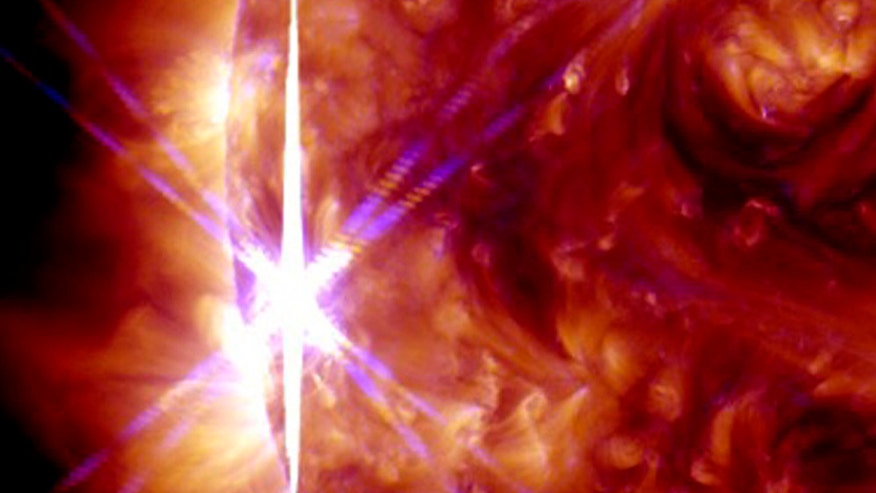
File photo. A solar flare is pictured erupting from the sun October 25, 2013 in this NASA handout photograph from its Solar Dynamics Observatory. (REUTERS/NASA/Handout via Reuters)
In the recently released “Maze Runner: Scorch Trials” trailer, kids have to survive in a world destroyed by solar flares.
Some researchers are warning not all states in the U.S. will be ready for the threat of solar storms. Will your state survive a mega-blast from the sun?
According to research from The Pew Charitable Trusts, some states are taking steps to protect the power grid from solar flare damage, while others are not.
A major solar storm with an intense radiation burst from the sun can produce an electromagnetic pulse (EMP). An EMP is a high-intensity burst of electromagnetic energy caused by the rapid acceleration of charged particles.
On the minor end of the spectrum, an EMP can create temporary radio blackouts and disrupt GPS navigation. On the larger scale, an EMP attack could devastate the US power grid and technological infrastructure sending the US back to the 1800s.
A near miss
Scientists recently revealed in Nature Communications that the Earth had a very near miss last year.
In early 2014, there was a giant solar eruption that scientists expected would strike Earth.
In terms of “space weather,” coronal mass ejections are like hurricanes. When these ejections happen, a billion tons of ultra-hot matter lashes out from the sun.
This one from 2014 was traveling at a speed of more than 5.3 million mph toward Earth. What would have happened if it made contact? Well, if it had struck, then it would have triggered a very strong geomagnetic storm.
Scientists believe the sun’s magnetic field unexpectedly deflected it away from Earth.
The consequences could have been serious.
In 1989, in the span of a few seconds, a coronal mass ejection blacked out the entire Canadian province of Quebec. The damage traveled to the United States as well as to New Jersey. It very nearly succeeded in shutting down the U.S. power grids from the mid-Atlantic through the Pacific Northwest.
An X1.6 class solar flare flashes in the middle of the sun in this image taken September 10, 2014, in this image courtesy of NASA. (REUTERS/NASA/SDO/Handout)
The threat
Space weather is very unpredictable. While scientists may be able to identify when a coronal mass ejection will strike Earth, they cannot predict how powerful an impact it will have until it strikes.
The concern is that an EMP could disrupt the nation’s electrical grid.
If a solar flare collapsed the national electrical grid, it would create many problems for security. Electricity and telecommunications would be unavailable for weeks and months. Other essential aspects of life could be affected as well from emergency services and sanitation to access to food and water.
The National Governors Association research on the threat identified that seventy percent of the country’s transmission lines and transformers are at least twenty-five years old. The research also revealed that 60 percent of the nation’s circuit breakers are at least thirty years old.
The researchers note that most electrical infrastructure was designed in the 1950s, making the larger system particularly vulnerable to solar flare disruption.
The Pew Charitable Trusts researchers reviewed the steps taken by the government to prepare for a solar flare and EMP event. They concluded that Congress has commissioned reports and held hearings about the dangers of solar storm events, but little action has been taken.
As a result, states have been implementing their own approaches to the threat. Some states have been introducing legislation to protect their critical infrastructure.
Legislators like Sen. Bryce Reeves, a freshman state Senator in Virginia, have been sponsoring measures to protect their home states against such threats. Some states like Louisiana and Kentucky are taking steps to study the threat while others like Arizona have been taking action with initiatives to prepare the public.
According to the Pew research, EMP or solar storm-related legislation has been raised in eleven states, but only enacted in five since 2013.
Ballet dancer turned defense specialist Allison Barrie has traveled around the world covering the military, terrorism, weapons advancements and life on the front line. You can reach her at wargames@foxnews.com or follow her on Twitter @Allison_Barrie.


